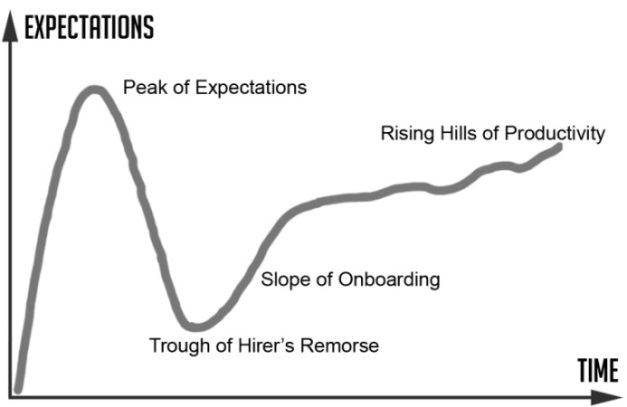ATD Blog
Constructing a Solid Sales Onboarding Program
Thu Jun 14 2018

Organizations are increasingly under pressure to reduce time to productivity–the average span of onboarding time required for a new hire. No role has a greater urgency to get sellers up to speed than sales development, due in large part to the shorter tenures of typical reps. In the following except from The Sales Development Playbook, Trish Bertuzzi explores effective methods and considerations for constructing an onboarding program where efficiency matters most.
Efficient Onboarding
Here is the reality, average sales development tenure is between twelve and eighteen months (with a three- or four-month ramp window). This leaves us with just under one year of full productivity per rep. That is not a lot of time to achieve an ROI from that role. A more efficient onboarding process can certainly assist.
When I speak with executives about their onboarding process, many will share some variation of this:
The first few days are new hire orientation.
Then we put them right into product and internal systems training.
After that, we have them listen to live calls with some of the more senior reps.
Next, we give them low-level leads to practice on.
Finally, at the end of week two, we put them in the lead rotation and they’re off to the races.
Think about that two-week plan. That isn’t how people learn—not effectively, anyway. In our rush to get our reps productive, we’re essentially bringing them in, telling them “Marc is good. Be like Marc,” booting them in the rear, and letting them have at it.
This makes about as much sense as teaching someone to drive by having him or her sit in the passenger seat for two weeks. Observation alone is great for being able to identify a good driver. But it’s a terrible strategy for becoming one.
I have a theory as to why this approach is so common. We’ve just gone through a tough process to source, interview, evaluate, and recruit these new hires. And if we’re being honest, we’re a tiny bit fatigued at this point. We’ve descended from the Peak of Expectations (I just hired an A-player! I’m awesome at this!) and encountered the Trough of Hirer’s Remorse (They seemed so brilliant during the interview). We just want to sprint straight up the Slope of Onboarding as fast as humanly possible to get to the majestic Rising Hills of Productivity (see figure below).

But here’s the larger problem: we’re undermining the serious investment we made in hiring top talent with a check-the-box onboarding process. As a result, too many sales development reps aren’t properly prepared to take the field.
How People Learn
Effective onboarding begins with an understanding of how people learn. Jill Konrath, an author and sales keynote speaker, believes that leaders misunderstand the best way to get reps up to speed quickly. “Managers will tell a new rep to get on the phone with John and listen to what he’s saying. Or go pay attention to what Katie’s doing because she’s really good. But there’s no connection between what this A-player does and how the new rep is supposed to get there. The manager pays no attention to transferring the knowledge and experiences that the new rep will need to be as successful as Katie and John.”
Jill has written an entire book, Agile Selling, on this very topic_._ Jill shared with me that new reps learn most effectively when the approach involves chunking, sequencing, and connecting. Let me summarize what that means.
Chunking. It’s easier to learn a new subject in bite-sized chunks. When you overwhelm someone, information isn’t readily absorbed. You have to break the material down into smaller, easier-to-absorb blocks. For example, learning about all the different prospect personas involved in your sale can be overwhelming. Expose new reps to each persona—one at a time. Paint the picture for how they relate to each other and form the org chart.
Sequencing. Determining what comes first, in order of importance, is key to learning (think: logical building block). Decide what’s essential to learn now versus what can wait. It does little good for new reps to learn features and benefits before they learn about prospect pain and the implications of the status quo.
Connecting. This ties it all together. You’ve created a learning sequence built with bite-sized chunks of information. Now you need to connect the dots. Say your reps have just learned about prospect challenges and prospect personas. Now, help them link each prospect to the business drivers that resonate best with them. Then when you cover messaging, reps will understand the story behind the story.
How many of us build our onboarding plans with these three concepts in mind? We (as leaders) are in a great big hurry to get our people up, running, and productive. It goes against our instincts to slow down the learning. We incorrectly assume, "If shadowing top reps and role playing are good, then eight hours of nothing but shadowing top reps and role playing must be very good." It’s cliché to describe onboarding as “drinking from a fire hose,” but it’s also an apt description.
The reality is that as we pour and pour all this new information into reps’ ears, the more and more confused they get and the longer it takes for them to get up to speed. If you take away nothing else from this section, remember this: Keep onboarding sessions short. Make the order purposeful. Let them sleep on it. Learn, then do. Revisit. And revisit again. This is how people learn.
If you embrace these principles, your onboarding will give reps both a clear picture of how all the different components tie together and a vision for how what they’ve learned will help them in the daily realities of their role. The good news is that great onboarding doesn’t require a PhD in learning science or a team of engineers from Porsche to build.
You've Reached ATD Member-only Content
Become an ATD member to continue
Already a member?Sign In
